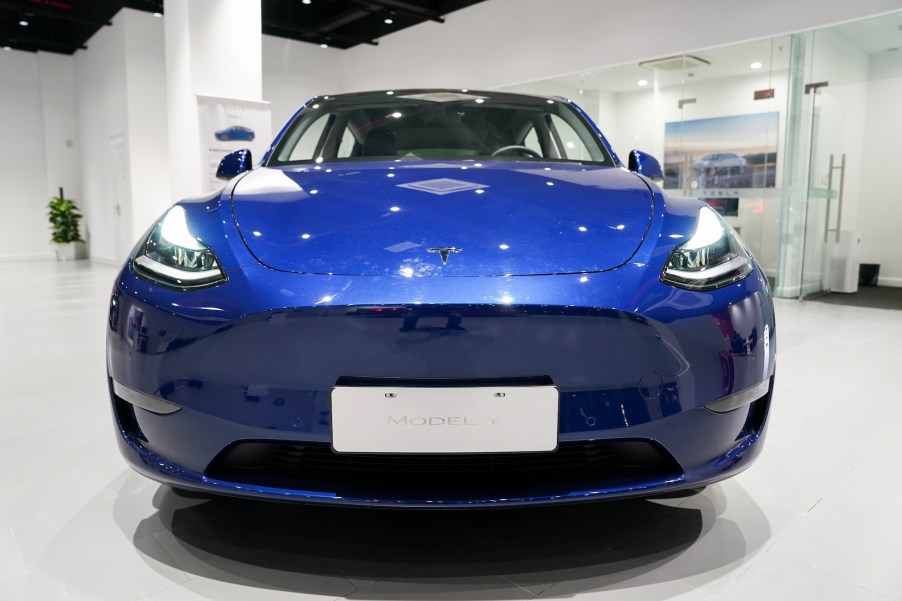
How Much Does a 2021 Tesla Model Y Cost?
The Tesla Model Y is relatively new to the EV maker’s ever-expanding lineup. CEO Elon Musk began teasing an electric compact crossover utility vehicle (CUV) concept in 2015. Three years later, he announced he’d finally approved a consumer-ready Model Y design. As promised, Tesla began production and delivery of premium all-wheel-drive versions in the first quarter of 2020. Since its release, the Model Y has garnered much-earned respect from consumers and competitors alike.
However, it’s also the least reliable Tesla, according to Consumer Reports. So if you think you might want one, read on before placing an order.
Volkswagen’s CEO called the Tesla Model Y is a ‘reference’
In September 2020, Volkswagen CEO Herbert Diess shocked social media with a series of LinkedIn posts outright endorsing Tesla’s Model Y. He test-drove the Model Y, and it impressed him. Not only that, but Diess also wasn’t shy about expressing approbation for his competitor’s all-electric CUV. He even admitted to using the Model Y as a reference for the Volkswagen ID.3.
But Diess seemingly threw shade at Daimler and other rivals: “Many of our competitors are still using their ICE [internal combustion engine] platforms. The result: They aren’t getting the best EVs.”
VW builds its EVs on the Volkswagen Group MEB platform, or “modular electric drive matrix.” Nothing like delivering a mike drop while boasting the tech cred to back it up.
The 2021 Tesla Model Y is affordable until you start adding options
The Tesla Model Y is the second vehicle borrowing much of its design from the Model 3 sedan platform — the Model S was the first. Around 75 percent of its parts and components are the same or similar to the Model 3’s, such as the chassis, electric powertrain, and interior design. The Tesla Model Y is a slightly smaller, more affordable alternative to the bigger, stronger, and noticeably pricier Model X.
You can choose from three trims: the Standard Range (base trim), the Long Range (mid-level), and the Performance (top-tier). A single motor powers the rear-wheel-drive Standard Range. It has an EPA-estimated range of 244 miles, accelerates from 0 to 60 mph in 5.3 seconds, and tops out at 135 mph.
The Long Range and Performance models are dual-motor all-wheel drive. However, despite accelerating from 0 to 60 mph in 4.8 seconds, it’s no faster than the Standard Range. As the name suggests, the Performance trim offers a significant performance boost. With an EPA-estimated 303-mile range, it accelerates from 0 to 60 in 3.5 seconds and reaches a top speed of 155 mph.
The base Tesla Model Y starts at $34,190. However, upgrading to seven seats and opting for the red multi-coat paint job, 20-inch induction wheels, towing hitch, black and white interior, and self-driving capabilities will have you nearly touching the $60,000 ceiling. Adding the same packages to the Long Range and Performance trims tops out at $62.500 and $72,500.
Unless your houseplants grow $100 bills rather than leaves, paying that much for the Performance Model Y might be a bad idea. This holds especially true with the luxury-EV market promising greater options as early as this year.
Over 40 EVs could hit the market by 2025
After comparing the Standard and Long Range options carefully, you might find that the latter offers more bang for your buck. But then again, the EV market is just getting warmed up. Just because Tesla earned its clout as a trendsetter doesn’t mean it’s a trend leader. Proving that point, Car and Driver recently listed over 40 EVs hitting the market between 2021 and 2025.
As we’ve covered over the past few months, South Korean automakers are a force to be reckoned with in innovation. As an example, the 2021 Hyundai Kona Electric starts at $37,390 and offers a range of 258 miles. The Kona Electric Ultimate starts at $45,600 and offers many standard features the Model Y lacks. Not only are Apple CarPlay and Android Auto standard across the line, but Kona also offers more standard safety features than some luxury brands. The Insurance Institute for Highway Safety (IIHS) named it a 2020 Top Safety Pick.
With Tesla still striving to improve its reliability ratings and rivals starting personal feuds with Elon Musk (among a long list of other issues), the EV maker’s time in the spotlight might be limited. Once an automotive segment turns competitive, it’s do-or-die for the competitors. Can Tesla keep up with the growing pressure? We’ll find out over the next few years.


